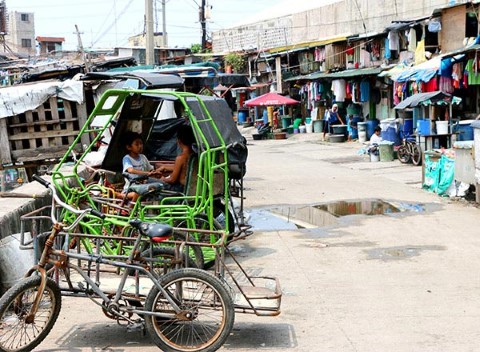- Thought Leadership
Carmie Carpio, a field correspondent in Quezon City, Philippines, shares a few of the amazing photos she took of rural and urban life in and around the areas where Children International works.

These boys catch their breath in a pedicab after playing. Pedicabs, which are bicycles with sidecars, are a typical means of transportation in small communities, especially where streets are very narrow. Many of the kids here will become pedicab drivers when they get older to help support their families. Some of Children International’s very own enterprising and motivated youth also operate their families’ pedicabs on weekends and before or after school to help supplement household income.

They call this makeshift raft a “RORO,” which stands for “roll-on, roll-off.” This one is used for crossing to the other side of this estuary and costs 5 pesos to ride. Holding the rope, the “driver” pulls the raft forward to reach the opposite shore. Houses and several huge factories, one which makes candies and paper products, are built near the water. It's not a healthy environment for children. The water is dark, murky and lined with trash; the smell of the polluted water hangs in the breeze.

I captured this image of a little boy and the world he knows – bleak, dirty and desolate. He probably never imagines a future elsewhere. This is why even the simplest intervention has an impact on a poor child's life. Families here who have sponsored children find immense hope. Their children's health and education are supported and fostered. And they are given opportunities to pursue a better future and to help improve their communities, such as cleanup projects through the Youth Empowerment Fund.

San Miguel Island is rural and peaceful with lots of hills, green spaces and a majestic view of the Lagonoy Gulf. Life seems to run at a slower pace here. The Mayon Volcano (or Mount Mayon) can be seen on the mainland. A landmark of the country's Bicol region, this active volcano is well-known for its almost symmetrical conical shape. It's beautiful but also deadly. Thousands were evacuated in 2014 when Mount Mayon threatened to erupt.
I was born and raised in Bicol, so this region is close to my heart.

Filipino outrigger boats like these are called "banca." These boats are used for fishing and transportation between islands and the mainland.
We had to take a banca from Legazpi (about a 25-minute ride) to get here. On the shore, several guys with motorbikes were waiting to take passengers to their destinations on the island. Only motorbikes can access most of its narrow roads.

This is another photo taken in the Bicol region. We were traveling to Mabuhay Village, a free permanent housing project Children International built for sponsored survivors of a deadly typhoon several years ago. This view is from an elevated part of the village. It's possible that a family lives in this hut, or it could be simply a resting place for a farmer. It gets very hot most days, and farming requires hours of planting under the sun, so they need a shelter to rest. The rice field seems to be surrounded by vegetables. Those growing alongside wooden stakes are bitter gourd plants.

This is at the base of the seven-tiered Busay Falls, a little more than a kilometer from one of our community centers in Tabaco. Kids often play here, along with visitors hoping to cool off in the crystal-clear water. Some hike Mount Busay to experience the seven falls. I wish we would've had enough time to do that, but we were content with the relaxing sound of the falling water, flowing river and echoes of children's laughter. It's a beautiful place to commune with nature and relax.

This alley is near one of our community centers in Quezon City. The concrete pipes in the background are culverts that will be put underground to drain unwanted water during floods, which happen a lot in rainy seasons. Road work like this is common in communities and interferes with traffic and inconveniences residents and visitors. But many children love to play in the culverts.

When it's raining, the community seems a little more peaceful, and the noise from vehicles and passersby gets drowned out. These low-hanging, tangled power lines are a common sight, sometimes much worse than what's shown here.

I happened to pass by this hilly community in Quezon City, and these clothes caught my eye. This is not where clothes are typically laid out to dry, but the heat-conducting metal of the corrugated roof likely contributes to faster drying. Usually clothes are hung on lines outside of homes or windows. Families wash clothes by hand, sometimes in groups, at outdoor faucets, wells and community pumps. A few families have simple washing machines inside their homes.
After the massive fire in Quezon City at the beginning of the year, many of the families and children returned to the area to collect scraps to resell in junk shops. The metal sheets on this cart are from the carnage. Massive scavenging like this took place for days. Apart from providing needed money, this activity helped clear debris from the razed area.
This boy playing in the dirty water – black from ash and burned materials – is from the same gutted community. (His blond hair caught my attention!) He was there with residents searching for scraps and materials to sell, and he was trying to help – digging and picking through the dirt and pools of water – but ended up merely playing.